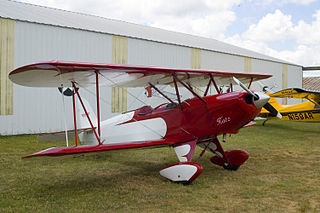
The Hatz CB-1 is a 1960s American light biplane designed by John Hatz for amateur construction. The Hatz Classic variant is supplied in kit form by Makelan Corp of New Braunfels, Texas, while the other variants are available as plans only.

The Gregor FDB-1 was a Canadian biplane fighter, designed in 1938 by Michael Gregor and manufactured by Canadian Car and Foundry. Despite having some advanced design features such as flush rivetted all-metal construction and a retractable undercarriage, the final generation of biplane fighters was being supplanted by monoplanes and the Gregor FDB-1 was obsolete before it flew. Despite the Royal Canadian Air Force's desperation for modern fighters, the sole example remained unsold and was eventually lost in a fire in 1945. The Gregor FDB-1's model designation stood for Fighter Dive Bomber indicating its intended roles.

The Pitcairn Mailwing family was a series of American mail carrier and three-seat sport utility biplane aircraft produced from 1927 to 1931.

The Pitcairn OP-1 was the first rotary-wing aircraft to be seriously evaluated by any of the world's major air forces. The machine was not a helicopter, nor an airplane, but an autogyro. Pitcairn's model was never put into production for any military.

The Darmstadt D-22 was a sports-plane of Germany, designed and built by Akaflieg of Technische Universität Darmstadt.
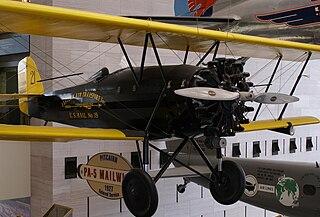
Harold Frederick Pitcairn was an American aviation inventor and pioneer. He played a key role in the development of the autogyro and founded the Autogiro Company of America. He patented a number of innovations relating to rotary wing aircraft.

The DFW Mars was an early German military utility aircraft built in 1913 and was the first original design manufactured by DFW. The aircraft was produced in both monoplane and biplane versions, which shared a common fuselage and empennage. The monoplane version featured wings that were wire-braced to a kingpost on the forward fuselage, and was powered by a 71 kW (90 hp) NAG engine. Examples of the monoplane built as dedicated trainer aircraft also incorporated a reinforcing truss beneath the wings. The biplane had conventional three-bay wings of unequal span and was powered by a 75 kW (100 hp) Mercedes engine. The wings of both the monoplane and biplane versions featured prominent sweepback.

The Pitcairn PA-34 and Pitcairn PA-33, given the United States Navy (USN) designation Pitcairn OP-2 and United States Army designation Pitcairn YG-2 respectively were reconnaissance auto-gyros designed and built in 1936 for evaluation.

The Pitcairn PAA-1 was an autogyro developed in the United States in the early 1930s. Of similar configuration to Pitcairn's earlier machines, the PAA-1 had an airplane-like fuselage with two open cockpits in tandem and a tractor-mounted engine in the nose. It was also equipped with small wings, which carried control surfaces, rather than using the rotor for flight control. It was a smaller and lighter machine than its predecessors and was designed specifically with private pilots in mind.

The Fairey Fleetwing was a British two-seat, single-engine biplane designed to an Air Ministry contract for carrier-based reconnaissance operations in the late 1920s. Only one was built.

The Smith DSA-1 Miniplane is a single-seat, single-engine sport aircraft designed in the United States in the 1950s and marketed for home building.
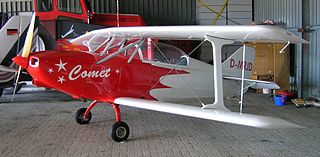
The B&F Fk12 Comet, also called the FK-Lightplanes FK12 Comet, is a single-engine, two-seat sports biplane designed in Germany. First flown in 1999, it was available as a kit or complete and ready-to-fly.

The Pitcairn PA-3 Orowing is an early Pitcairn biplane designed for light commercial use in the early 1920s when aircraft production rates did not meet demand for airmail, training, and passenger aircraft.

The Curtiss Oriole was an American three-seat general-purpose biplane.
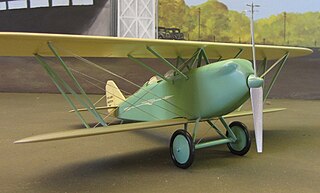
The Pitcairn PA-2 Sesquiwing "Arrow" is an early biplane designed for air racing and commercial airmail service.

Agnew Emiel Larsen was an American aircraft engineer who designed a series of pioneering airmail aircraft, and engineered progressive improvements to rotary wing aircraft that are in use in most modern helicopters currently. Larson invented an inflatable gyrocopter parachute that was featured in Popular Mechanics.

The Pitcairn PA-4 Fleetwing II, also called the Pitcairn Fleetwing DeLuxe, and the Pitcairn PA-4 Fleetwing is a commercial mail hauling and passenger biplane.
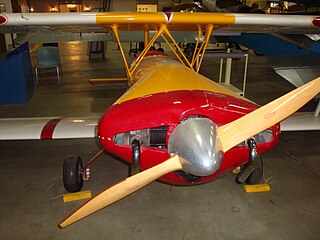
The Der Kricket DK-1 is a single seat, single engine biplane designed and built in the United States in the 1970s with an emphasis on simplicity. Several were built, as intended, by amateurs from plans in addition to some constructed by the four man design consortium.
The Shirlen Big Cootie is an American homebuilt biplane that was designed by Roy Shirlen.

The 1933 experimental Pitcairn PA-22 was one of the first wingless autogyros. It was controlled by movement of the rotor plane rather than the usual control surfaces, though initially the much modified lone example retained rudders as a precaution.




















